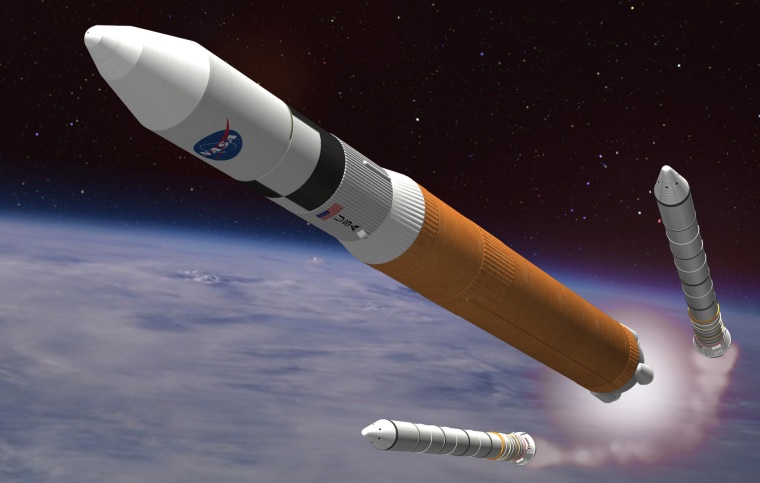NASA has told lawmakers that it could build a heavy-lift rocket incorporating the space shuttle’s main engines, giant external tank and taller versions of the shuttle's solid-rocket boosters — but not within Congress' budget and timetable.
The NASA report, mandated by an authorization bill that became law last October, drew a tart response on Thursday from two leading senators who helped push the bill through Congress. Sen. Bill Nelson, D-Fla., and Sen. Kay Bailey Hutchinson, R-Texas, told NASA Administrator Charles Bolden in a letter that the law "is not an optional, advisory document."
They told NASA that plans to build a heavy-lift rocket and a new space capsule to carry astronauts by the end of 2016 "should be carried out, unless the agency can demonstrate why they are infeasible or impossible to perform."
The NASA Authorization Act of 2010 directed the space agency to get started this year on a multipurpose crew exploration vehicle and a heavy-lift rocket initially capable of hauling 70 to 100 metric tons of payload to orbit. The law gave NASA 90 days to produce a heavy-lift launch vehicle study.
On Monday, the space agency issued a 22-page study to lawmakers to satisfy that legal requirement.
Shuttle technology adapted
Doug Cooke, NASA associate administrator for exploration systems, outlined the agency's heavy-lift rocket design during a presentation to the NASA Advisory Council's exploration subcommittee in Washington on Tuesday.
Cooke said the agency concluded that the best approach for meeting the heavy-lift requirements spelled out in the law would be to build a rocket that incorporates the shuttle's external tank, five space shuttle main engines, a J-2X-based upper stage and two five-segment solid-rocket boosters.
Such a system would be similar to the launcher that was being developed as part of NASA's Constellation back-to-the-moon program, which the Obama administration has targeted for cancellation.
The authorization act gave NASA until 2016 to field the heavy-lift rocket and crew vehicle, and authorized more than $10 billion in spending on the two projects over the next three years.
NASA's study said its options for future spacecraft development would not "fit the projected budget profiles nor schedule goals outlined in the Authorization Act."
The study said "none of the design options studied thus far appeared to be affordable in our present fiscal conditions, based upon existing cost models, historical data, and traditional acquisition approaches."
Cooke said NASA would deliver a final report to Congress in the spring, pending the results of study contracts that were awarded to 13 U.S. companies in November. Those contracts are expected to yield a wide range of launch vehicle design proposals — and they may suggest some fresh options.
Work with us, senators say
In their letter to Bolden, Nelson and Hutchison said NASA's study contained "no specific justification or analyses" to back up the agency's claim that its design options were unaffordable.
"We expect NASA to work with Congress to identify the basis for the claims made in the report, how existing contracts and technologies will be utilized, and where any additional congressional action may be needed to ensure successful implementation of the law," they said.
Under the continuing resolution that currently governs NASA spending, the agency is barred from terminating its old Constellation contracts, even though the White House wants the program canceled. The senators promised to work with their colleagues in Congress to put through an updated appropriations bill for NASA as quickly as possible.
"In the interim, we urge you to continue moving forward with the contract modifications necessary for the space launch system and multipurpose crew vehicle development that are not impacted by the prohibition on termination," the senators said.
NASA's current plan is to retire the space shuttle fleet after Endeavour's mission to the International Space Station in April. The Authorization Act gave NASA the go-ahead to plan one more space shuttle flight this summer, but the continuing resolution does not set aside extra money for extending shuttle operations. That would have to be done in a new appropriations bill.
When the 30-year shuttle program ends, NASA plans to rely on foreign-built space transports as well as U.S. commercial spaceships to resupply the space station. The heavy-lift vehicle would be used in the longer term for trips beyond Earth orbit — perhaps to an asteroid, or round-the-moon trips, or even voyages to the moons of Mars.
More from Space.com:
- NASA's New Direction: FAQ
- Photos: Building Space Shuttle Discovery
- NASA Doles Out $7.5 Million for Heavy-Lift Rocket Studies
This report includes information from msnbc.com as well as Space News via Space.com.
